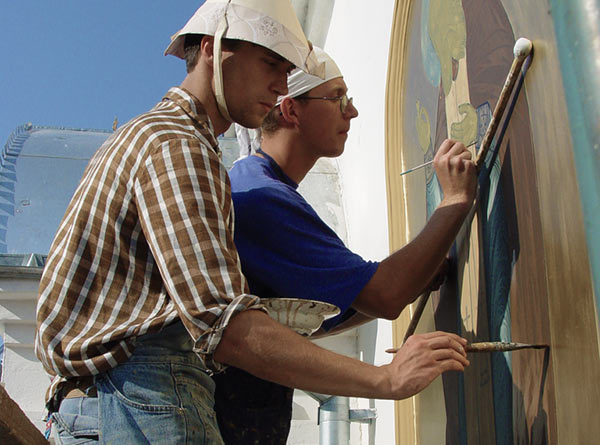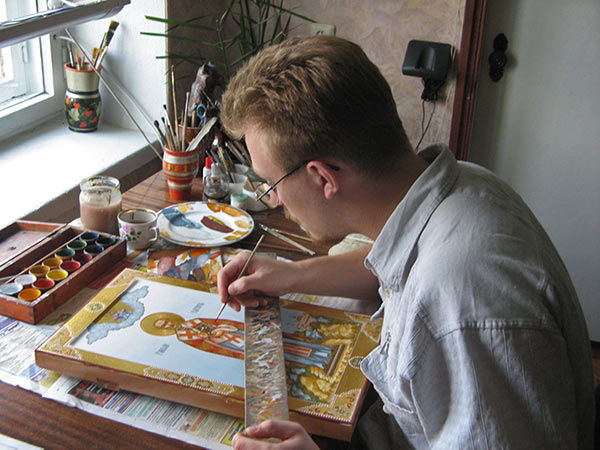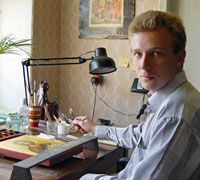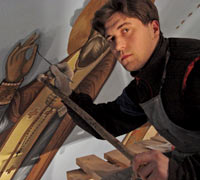About us
 |
||
 |
||
 |
Palekh icon-painting traditions Olga Kolesova |
The workshop headed by Alexander Kuzmenko and Leo Lopatin has accumulated rich working experience, which, according to Alexander Kuzmenko, was not that easy to gain. The skills and knowledge obtained in Palekh Art College were far from enough, which had to be compensated by the great interest of the painters in the art of their predecessors and the advice of the veterans of the trade. |
Today, following experience of the old masters, the icon painters of the workshop create masterpieces which embody centuries of icon painting tradition. They are extremely skilled in icon and mural painting. Their competitive advantage is the most responsible attitude towards their work and customers’ demands.
Palekh icon painters, shedding the paints onto fresh mural walls gave flesh to the Testament texts, if not the one they could see around them, then the one they could envision in their potent minds… They painted with tempera paints and gold’, this is what people used to say about icon painters of the past.
Following traditions, the painters of the workshop have mastered the technique of egg yolk tempera and leaf gold painting. Moreover, they have gained utmost skills in applying primal coating, incusing on it, gilding with natural leaf gold. They successfully combine old techniques with modern durable materials. The work is done quickly and professionally, using modern materials and strictly following Palekh icon painting traditions. Questionless, all the customers’ demands are met and taken into consideration.
 |
||||
|
||||
 |
Nowadays, when the renovation of previously damaged churches is reaching its heights, the interest in the workshop is steadily growing.
Let us view the main types of artwork the studio performs. First of all, it is monumental painting of churches and creating various kinds of icons: cellular, lectern, family, signature, measured, travelling, temple and iconostasis. And what can be said about particular details of icon-making process? One of the strictest traditions of Palekh art starts with an important working stage when a wooden intermediate product is selected. It can be produced either of common or fine wood. All materials are utterly conditioned and then dried properly.
An important stage is applying the prime coating which is mainly gelatin-based and is applied in several layers, every of which is properly dried before applying the new one. After the prime coating is done the icon surface is polished to reach a certain glossy condition.
At the customer’s demand the icon may have compositional incusing at the margins, in the background or on the halos of the saints. Next the icon is gilded, which gives it a touch of a genuine masterpiece.
Glossy gilded surface is a traditional feature of a Palekh icon, whose secret has been kept by generations of icon painters. Also, the ornaments on the gilded surface may have some enamel elements, the technique of which is also considered one of the secrets of the trade. The elaborateness may vary from icon to icon: it may contain incuse work, enamels, it may be a single half-length image or a detailed many-figured composition.
 |
||
 |
||
 |
The painting is done in egg tempera paints dissolved in the domestic egg yolk emulsion. In the old times the icons were painted by several painters. One of them was responsible for painting the clothes, that is why such master used to be called a ‘dress painter’. The second one painted all the details excluding faces and the open parts of the saints’ bodies. Such painter was called a ‘pre-facial master’. The rest was done by a ‘facial master’.
The old painting traditions are strictly followed in Kuzmenko and Lopatin studio. That is why the icon painting is carried out by several painters: the first one applies the primal color coatings working on the background, landscapes, margins, clothes and underpaint. Then the icon gets into the possession of a pre-face painter whose responsibilities are details on clothes, shade strokes, which can be done in paints or gold. The most important stage of the work is painting a saint’s face. This work is done by a professional face painter. The final stage is polishing and finishing, which carefully follows the strictest technological demands.
Vivid colors, charming expressions of figures, emotionality of their gestures, delicacy of floral ornaments and a bold and neat composition are those qualities which let Lopatin and Kuzmenko studio stand out among the icon-painting workshops. That is the way our old Palekh traditions regenerate themselves. Remarkable and well-recognized style of icon-painting, which has been kept and protected as valuable treasure of Old Russian art culture, is now coming back to life. Great achievements of famous painting schools such as Novgorod, Stroganov, Yaroslavl and Moscow schools, have found their second life within the painting traditions of Palekh. That is why archeologists, experts and amateurs have been so much appreciating old Palekh. And now the traditions of Palekh icon-painting school is carefully and honorably represented by Lopatin and Kuzmenko studio.


